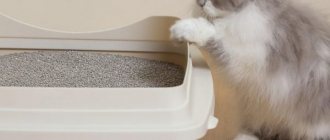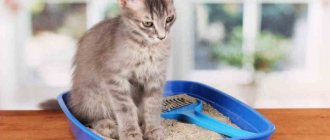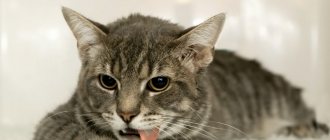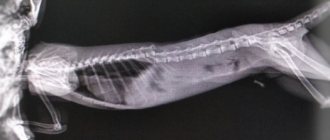8929Administration
2
A person needs to take care of someone. It is easiest to show compassion for our smaller brothers. This is why people so often get cats. Having appeared in the house once, they become objects of adoration for all household members for a long time. Love and affection are great, but no one is immune from problems. At one point you may wonder: what to do if the cat hasn’t written for a day? Every owner is attentive to his pet, and therefore he will probably notice his problems with the toilet. The most important thing is to act competently and with a cool mind, and then the problem will be solved easily, even if the cat has not peed for more than a day.
Description
Cats are light-drinking animals.
They go without water for several days, obtaining moisture from urine. They can endure for a long time without visiting the litter box due to stress, unpleasant odor or new litter. But the concentration of urine is constantly growing. Coupled with a sedentary lifestyle, these factors make the urinary system a weak point in cats. The kidneys continuously cleanse the blood of toxins, are responsible for the acid-base balance, participate in metabolism, and perform an endocrine function. A healthy cat pees at least three times a day, getting rid of salts and protein breakdown products. Fresh urine has almost no odor, is light and transparent.
The condition when a cat cannot pee leads to serious consequences for the body:
- urine goes out - intoxication increases;
- water, acid-base balance is disturbed;
- with increasing urine concentration, the walls of the bladder are damaged;
- bacteria are not washed out of the urethra, reproduction leads to ascending infections;
- Within a day, azotemia develops - the accumulation of metabolic products in the blood. This is an emergency condition in which 10% of patients die even in a hospital setting;
There are two options for urinary retention. With kidney failure, urine is not produced. With obstruction, the cat cannot pee due to a “plug” in the ureter, bladder neck or urethra. That is, the cat either has nothing to pee with, or urine cannot come out due to an obstruction. The urethra of cats is wider and shorter, so they are less likely to suffer from blockage than cats.
What can cause such a condition?
Many owners of mustaches are interested in why problems with urination occur? Your pet rarely goes to the toilet for several reasons:
- Low urine output can be caused by insufficient fluid intake. A small amount of urine contains a high concentration of salts, from which stones subsequently form.
- Hereditary factor. If a cat has had similar diseases in its family, then it is more likely to have problems with urination than those animals whose heredity is not burdened with such issues.
- Physiological features. There are cases when a kitten is born with a urinary tract obstruction. This issue can only be resolved surgically.
- Improperly managed cat nutrition can lead to heavy urination. Excessive consumption of raw meat and fish, salty and mineral foods can provoke this problem.
- A cat may rarely go to the toilet if he is overweight. As a rule, such pets lead a sedentary lifestyle, which can cause poor urine flow.
- This reaction occurs after suffering stress. This could be a sudden move, a change of owner, or a trip on public transport.
There is an opinion that cats that eat dry food are more likely to develop urolithiasis. However, this is a misconception; on the contrary, dry food is a more balanced source, the main thing is that the cat always has fresh water available.
General symptoms
If the tray is open, owners quickly detect urine retention - the litter remains dry. When time is lost, the general condition worsens to the point of refusal of food, apathy, and coma. Symptoms vary depending on the cause of the condition.
Obstruction
There is urine, but something is preventing it from coming out. In addition to the presence of stones, obstruction is caused by neoplasms, injuries, parasites, and inflammation. Sometimes we are talking about congenital pathology. The cause of the obstruction may be a spasm caused by stress or illness.
Constantly running to the litter box, the cat cannot pee for a long time or urine leaks drop by drop. The pet tenses as if defecating, meows in pain, takes a long time to choose a position, and licks itself. There is an urge, but going to the litter box does not bring relief. Due to a full bladder, the abdomen becomes tight. If your cat pees blood, the urinary tract is most likely damaged.
Dysfunction
There is no or very little urine. The abdomen is not tight, but abdominal pain is possible - the posture is constrained, movements are cautious, weakness increases. The urge is of normal intensity or absent. The discharge is scanty, cloudy or absent. The cat's breath smells obsessively of ammonia or rotten fish.
If this is not an acute condition, at first everything is relatively fine. Owners think about how to make the cat pee - change the litter, drink it out. As it worsens, swelling of the paws and collar area develops. Possible pulmonary edema, tachycardia, cough. The body gets rid of toxins in other ways - vomiting, diarrhea.
Normal frequency of urination in cats
Kids go to the litter box several times a day, adult cats once, males - 1-2. There is no need to worry about going to the toilet more than twice as long as your pets are feeling well. It’s not a problem when cats double the number of trips during estrus, and neuters are emptied 6 times a day.
It is worse when there is urinary retention. If no traces of urine are found on the tray for more than two days, then the cat has anuria - a terrible symptom that can lead to overflow and rupture of the bladder and the death of the animal.
Causes of urinary retention
Only a veterinarian should find out why a cat cannot pee. You cannot rely on forum advice or “experienced” acquaintances - every hour the chance of survival decreases. There are many reasons, but 90% of cases occur due to urolithiasis, kidney failure and cystitis.
Urolithiasis (UCD)
Formation of sand, kidney or bladder stones. More often we talk about struvite - a mixture of phosphorus, ammonium, calcium, and magnesium salts. About 20% is oxalates, which cannot be dissolved. A complex of reasons leads to the formation of stones:
- violation of water-salt metabolism, insufficient fluid intake, dirty water;
- improper feeding - mixed, excess protein, fish, fatty foods;
- hereditary predisposition, congenital structural pathologies;
- low mobility;
- infections.
Because of stones in the ureter or urethra, the cat cannot pee, meowing in pain. The scanty discharge smells putrid and is mixed with blood. A pet experiencing suffering takes a characteristic pose, trying to empty its bladder on the owner, table, pillow. This is a demonstration of malaise.
Renal failure (RF)
Partial or complete loss of organ function, can be acute (AL) or chronic (CRF). The disease is prone to relapse and is incurable. When the creatinine level is up to 200 units. there is a chance of stable remission, up to 400 units. the condition is conditionally reversible, above 600 is critical.
CRF often affects older cats and animals with congenital pathologies. In the initial stages there are no symptoms, except that the pet drinks a lot and often pees profusely. When kidney function is reduced by half, the cat cannot go to the toilet. Symptoms:
- poor appetite, thinness
- lethargy, depression, apathy
- nausea, drooling, vomiting, constipation
- decrease in the amount of urine excreted
- swelling, hind limb paresis, confusion, convulsions
With acute renal failure, symptoms increase over several days or even hours. No appetite, severe thirst accompanied by sudden weakness, vomiting, pink urine. The temperature drops, tachycardia, cough, coma.
| Type of acute PN | Causes | Pathology |
| Prerenal | Cardiovascular failure, shock, sunstroke, excessive bleeding, major trauma, severe dehydration, acute intoxication | A sharp decrease in the amount of blood circulating through the kidneys, there is nothing to produce urine from |
| Renal | Nephritis, kidney infections, drug intoxication, DIC syndrome, poisoning with poisons, chemicals, heavy metals | There is enough blood, but the affected organ tissues cannot cope |
| Postrenal | Blockage or compression of the urinary tract | Urine forms, but does not swell |
With advanced renal PN, the prognosis is unfavorable, in other cases it is cautious. The effectiveness of therapy depends on the general condition of the pet and the timeliness of first aid provided.
Cystitis, urethritis
Inflammation of the bladder (cystitis), urethra (urethritis), and both (urocystitis). At first, the pet pees a lot and often, then blood and pus appear in the urine. The mucous membrane swells, clots of blood and pus clog the ducts, which is why the cat cannot pee. Causes of cystitis, urethritis:
- hypothermia, stress
- chronic inflammatory processes
- other diseases of the bladder, kidneys
- circulatory disorders, urinary, urethral trauma
- improper feeding, low mobility
- parasites, genitourinary infections, viruses
The general condition is lethargic, the cat drinks a lot, does not allow his stomach to be touched, and licks himself often. An elevated temperature drops as intoxication increases - a bad sign. Acute cystitis without treatment turns into a chronic form, prone to relapses.
The cat cannot go to the toilet - alarming symptoms
Untimely outflow of urine can provoke life-threatening conditions for the cat. In stagnant urine, pathogenic bacteria multiply rapidly. The bladder may not be able to withstand the strain. General intoxication of the body is no less dangerous for the health and life of the pet.
Therefore, it is so important to learn how to identify the first symptoms of painful and difficult urination. The following signs of trouble should alert the owner:
- the cat sits in the tray for a long time, spins around, chooses a pose, but in the end the tray is dry;
- the animal screams while trying to urinate;
- cats constantly lick the urethral area and meow pitifully;
- traces of blood, pus, and white flakes are visible in the urine;
- a sudden change in the color or odor of urine;
- urination disorders are accompanied by fever, lethargy, drowsiness, refusal to drink or severe thirst;
- the animal refuses to play, becomes aggressive, restless;
- the abdominal wall becomes painful and tense;
- cats meow and scratch when you try to pick them up.
If one or more symptoms appear, it is necessary to show the animal to a specialist for diagnosis and treatment.
Diagnostics
If the general condition allows, an ultrasound and x-ray of the abdominal cavity are performed on the day of treatment. Urgently do a general blood and urine test and biochemistry. The results show how damaged the kidneys are, the level of intoxication, the condition of the liver, and the degree of dehydration.
If urolithiasis is suspected, the acidity of the urine and the type of stones are determined in order to combat the problem in a targeted manner. For cystitis, it is advisable to take a smear for infection. Additional tests (extended biochemistry of blood, urine) are necessary when it comes to PN. It is important to talk about the volume and color of the discharge, how many hours the cat cannot pee, whether there is blood, vomiting, or thirst.
What does "little" mean?
Of course, all this is subjective and directly depends on physiology, habits, the amount and type of food consumed, and even the size and age of the animal, but there are still certain “norms,” if you can call them that. On average, a cat should walk “smallly” at least once a day. Of course, she can do this more often. Visiting the litter box once every two days is also possible, but this is not very normal and can already become a signal of deviations in the health and general condition of the pet.
It is also worth considering that an animal of average weight (3.5-5 kg) on average leaves about 120 grams of liquid in the tray every day, so if the cat runs to the toilet often, but with virtually no results, it’s time to start worrying.
Treatment
Since the condition is acute, first aid to the cat is provided symptomatically based on a preliminary diagnosis. It is important to quickly restore the water-salt balance, relieve intoxication, cleanse the urinary tract, and suppress infection.
First aid
The owner's help when the cat cannot pee is to immediately transport the pet to a doctor. You can’t wait, and trying to help yourself is also deadly.
What not to do, despite the widespread nature of the advice:
- forcefully drink. If the cat has PN, drinking water will contribute to swelling. If there is a blockage, the overfilled bladder will receive additional stress;
- apply a warm compress. Increases bleeding. Heat will accelerate the growth of bacteria, and the cat is already intoxicated;
- massage the stomach. It's painful and useless. If a massage fails to move a protruding stone, it can become deadly;
- give medicine for spasm. They contribute to increased bleeding. It is unknown what will happen to the stones;
- give diuretics, drugs with glycerin, essential oils, pinobin, cystenal, urolesan, phytolysin. They can dramatically worsen the situation, even leading to death.
You should not give Kotervin - it is effective for urolithiasis, but without a visit to the clinic, PN cannot be ruled out. And if the cat cannot pee due to decreased organ function, Kotervin is strictly contraindicated. Use painkillers with caution only if there are no contraindications.
Basic treatment
In case of obstruction by stones, a catheter is installed to drain toxic urine, followed by rinsing. Stones are dissolved with drugs or removed surgically. In severe cases, urethrostomy is performed - expansion of the outlet. After surgery, blockages are less common, but careful lifelong care is required due to the high risk of infection.
For cystitis, anti-inflammatory and antibiotics are prescribed, and further examination is carried out to determine the cause of the disease. For PN, therapy is long-term, up to lifelong. Depending on the reason why the cat cannot pee, treatment is carried out according to an individual scheme:
- solutions for relieving dehydration - saline, Ringer's, glucose, trisol
- blood pressure reduction – enalapril, ramipril
- analgesics, antispasmodics – papaverine, vetalgin, nosh-pa
- antibiotics SSD, oxytetracycline, amoxiclav, ciprofloxacin
- diuretics – furosemide
- hormones – dexamethasone, prednisone
- cardiac - cocarboxylase, riboxin, sulfocamphocaine
- hemostatic agents – vikasol, dicinone
- detoxification – lespenefril, sirepar, enterosgel
The pet must remain in the hospital for at least a day to assess the effectiveness of therapy, make adjustments, and provide emergency care in case of deterioration or acute reaction to the drug.
Is it dangerous for a cat to stop peeing?
If your cat stops urinating, it can be very dangerous. Any form of urinary tract blockage can lead to permanent kidney problems and can even be life-threatening. Because of this, you should always call your veterinarian if your cat hasn't peed in 24 hours. In most cases, you will be advised to come right away.
© shutterstock
It's always better to call a veterinarian sooner rather than later. The sooner your cat can be treated for health problems, the faster he will recover.
Do not try to express your cat's bladder yourself - this can be very dangerous for your pet. Large bladders due to blockage can “burst” at the slightest pressure, leading to death.
Prevention
Chronic diseases of the urinary system require careful monitoring. It is important to find a competent doctor who will develop an individual scheme and will thoughtfully adjust it as changes occur. The general approach with one prescription for all in the case of cystitis, urolithiasis and PN is disastrous.
Prevention of exacerbations is comprehensive:
- strictly follow the instructions without experimenting with medications;
- Together with your doctor, choose a diet or medicinal food with mandatory monitoring of blood and urine readings. No salt, fish, fat, excess meat;
- Filtered water should always be available - several bowls throughout the apartment. If the cat does not drink, switch to a semi-liquid diet;
- control the load - the pet should not sleep all the time, but too active games are contraindicated for it;
- avoid overheating, hypothermia, stress, injuries;
- take tests, ultrasound, x-rays every six months.
A filler that responds to changes in urine acidity will help control your pet’s condition. If you suspect a relapse, consult a doctor immediately. With each attack when the cat cannot pee, it will be more difficult to restore the functioning of the genitourinary system, so you should not lead the situation to urinary retention.
What to do?
If urinary dysfunction is definitely caused by stress, you should try to minimize it by giving your pet more attention and support, which is no less important for a cat than for a person.
If the cat does not like the new tray or filler, you need to return to the proven model of the tray and granules with the usual texture.
In all other cases, when the presence of a disease is evident, it is best not to try to self-medicate and contact a veterinarian as soon as possible to establish an accurate diagnosis and select the appropriate treatment.
Diet for difficulty urinating
For an animal that is susceptible to urolithiasis, it is necessary to create a corrective diet. His diet should be rich in glutamic acid and vitamins A, B 6. The following products should be excluded from the feed:
- Pork, since it is a very fatty meat that leads to thickening of urine;
- You should not give milk, as it contains a lot of magnesium, which will further impede the flow of urine;
- It is forbidden to add salt to food;
- Raw meat is also not recommended;
- Fish should be discarded, because the phosphorus contained in it is deposited by the excess mineral in the bladder, leading to the appearance of stones.
In general, it is better to give such an animal a balanced food specially designed for cats with similar problems.











